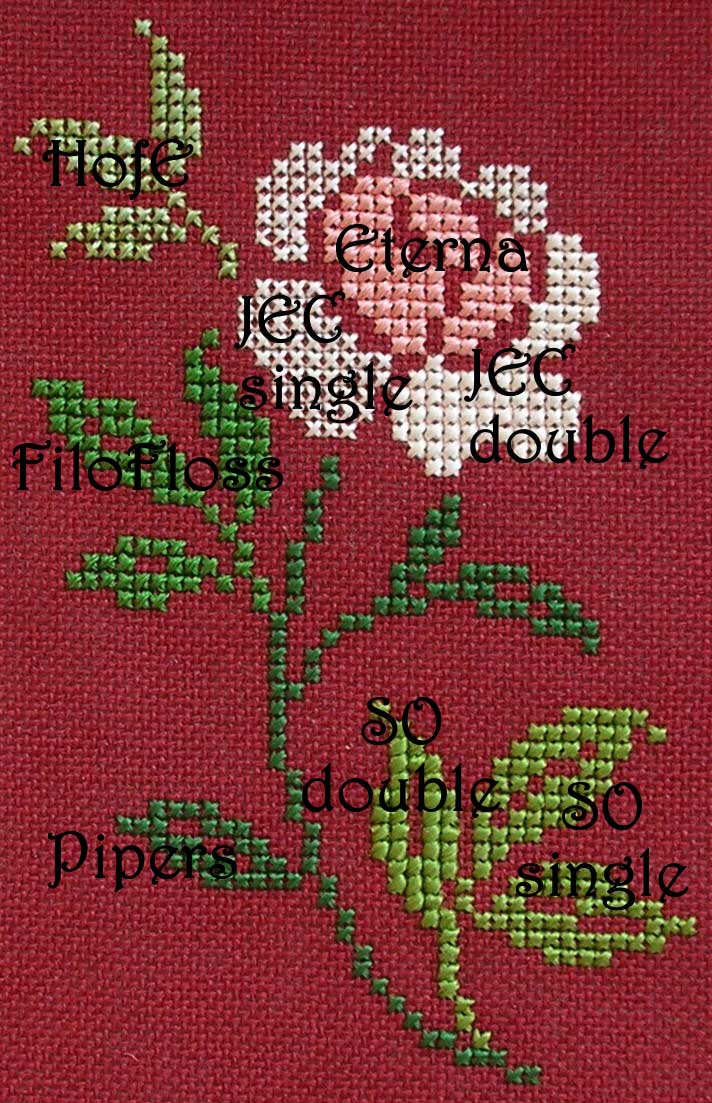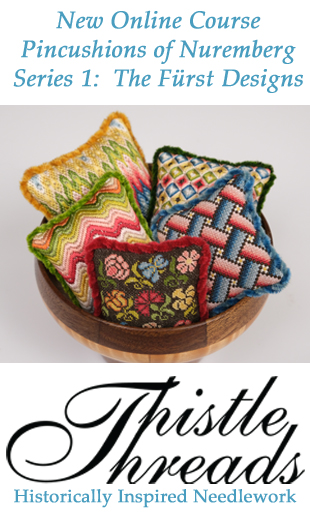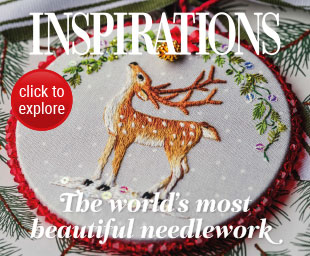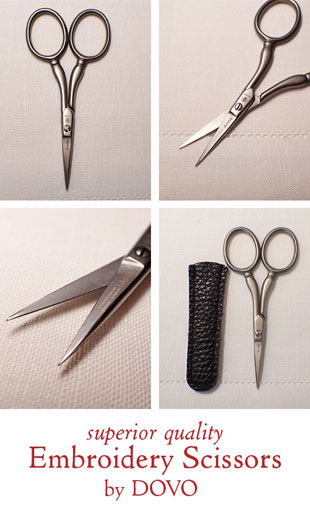Ilke, a reader from the UK, worked the following piece in order to compare different types of flat silk. She has written a comprehensive comparison between five flat (or “semi-flat” – if that’s an acceptible term!) silks available on today’s market: Eterna, Au Ver a Soie’s Soie Ovale, Piper’s (which is also the same as Helen Stevens’s True Embroideries Sleave Silk), JEC flat silk from the Japanese Embroidery Center, and House of Embroidery’s Fine Flat Silk. She also includes Pearsall’s Filofloss, which has been discontinued. For her impressions of these different silks, and a close-up look at them stitched, read on…
First, we’ll begin with the stitched piece that Ilke uses to demonstrate the various silks she is comparing in this “experiment.” I’ve left the photo rather large so that you can click on it and look at the stitches fairly close.

Now, I’m going to let Ilke tell you all about her experiment. You’ll find some very useful and thorough information here – I hope you enjoy it as much as I did!
This is a comparison experiment between the flat silks I’ve got. There are quite a few, but for the moment I will ignore the ones which either come in very few shades (like Erawan Thai silk), or which come in variegated shades only (like Stef Francis), because they aren’t suitable if you want to build up a collection with a good range of shades for ordinary charts (as opposed to monochrome designs, blackwork, Assisi designs or charts which are specifically designed for variegated threads).
Five flat silks remain: Eterna Stranded (ES), Au Ver á Soie Soie Ovale (SO), Pipers 90 Floss Silk (P), JEC Flat Silk (JEC), and House of Embroidery Fine Flat Silk (HE) (which is strictly speaking variegated, but has quite a few shades which are only very softly shaded). I’ve added a sixth silk, Pearsall’s Filofloss (PF) – it’s a flat silk which came in many different colours, but it has unfortunately been discontinued and replaced with Filoselle, which is a twisted silk.
All six silks are filament (reeled) silk (with the possible exception of HE); this means that the very fine filaments that make up the thread were reeled in one continuous strand from the silk moth’s cocoon, and not spun from short pieces and leftover odds and ends. Because filament silks are built up out of continuous filaments, they are stronger and less prone to fuzziness than spun silks. On the other hand, they do tend to snag quite easily, on anything that isn’t smooth – the edge of your fabric, rough skin, anything. Fortunately, it is also easily smoothed back into shape again, and can then be used again without looking any the worse for it.
ES and PF are stranded silks, 12 and 6 strands respectively, but because ES strands are so fine, the threads come to roughly the same thickness. ES strands are about 1/2a strand of DMC, PF strands are a little heavier than a strand of DMC.
SO, P, JEC and HE are single-stranded silks. SO is about 2 strands of DMC, JEC a little less than 2 strands, HE about 1 strand, P is about 1/2 a strand. SO and JEC, being thicker than the others, are a little less versatile in playing with different amounts of coverage, although they can be divided by very carefully separating the filaments (up to 16) which make up the threads – this is rather a fiddly job, though.
Each of these flat silks actually seem to give better coverage than their thickness would make you expect, because the silk lies flat and has a higher lustre than stranded cotton.
ES comes in 545 shades, in 5m skeins at $1.05
SO comes in about 50 shades, in 15m reels at $2.20
P comes in 224 shades, in 80m or 150m reels at $1 or £1.65
JEC comes in about 250 shades, in 60m reels at $7 or £4.70
HE comes in about 100 shades, in 30m card bobbins at £2.25 (100m reels are available direct from H of E, but I don’t know the price)
PF is no longer available; I don’t know how many shades it came in.
The amount of “coverage” you get per skein or reel compared to DMC stranded cotton is approximately as follows:
ES equals about 5m of DMC ($0.21/m)
SO equals about 5m of DMC ($0.44/m)
P equals about 6 1/2 or 12m of DMC (£0.15/m or £0.14/m)
JEC equals about 18m of DMC ($0.39/m or £0.26/m)
HE equals about 5m of DMC (£0.45/m)
Of these, I have read that only JEC is a truly flat silk. In practice there is little difference with P and OS, but ES, HE and PF are indeed a little less flat. In the case of ES and PF this may be because they are stranded, and have a slight twist to combine the strands, even though the strands themselves are flat. P and HE will usually have to be combined to get the required thickness, and so need occasional smoothing with the needle to get it to lie fully flat when stitched.
The project is stitched on burgundy 28ct Lugana over two.
I started with Eterna Stranded (the darker part of the rose). For good coverage, 5 strands are required. The strands lie quite flat without much help, although occasionally it needs a little smoothing with the needle. The silk snags fairly easily, but is as easily smoothed back into shape again. On the whole it is quite easy to work with, and it has a strong lustre. Drawbacks to this silk are that occasionally a skein may have some unevenness in some of the strands which cannot be smoothed out, and sometimes even broken strands; there are also occasional irregularities in the dyeing, leaving white spots. Even when this happens, however, only a very small part of the skein is rendered unusable, and as it is one of the cheapest flat silks around it is no great burden to buy a little more than you need, just in case.
The second part was stitched with JEC Flat Silk (the lighter part of the rose). In order to experiment with coverage, I stitched the left-hand petals using one thread, and the right-hand ones using a double thread. For good coverage, the double thread is needed; a single thread gives a more lacy effect. The thread lies perfectly flat without any assistance, but it does snag on absolutely everything, so it is essential to make sure that the edges of your fabric are smooth. As with the Eterna silk, however, this snagging has no lasting effect on its smoothness or its lustre, which is very strong with a slight haziness to the shine. In spite of the snagging, I found this a lovely silk to work with simply because it feels so smooth and looks lovely the moment you’ve laid a stitch; the sheen is very visible even when only one thread is used, but even stronger with a double thread (as there is more surface).
I then used House of Embroidery Fine Flat Silk for the top left-hand leaf. This silk surprised me, as it looks as though it has a very slight twist which might affect its sheen, but it stitches up beautifully with a lovely strong lustre. A double thread gives good coverage, and it is easy to work with, hardly snagging at all. It feels a little more springy than the other silks, and needs good tension and railroading to lie nice and flat.
The next leaf down is done in Pearsall’s FiloFloss. Two strands give very good coverage, and apart from some slight snagging it is easy to work with, although it does need “dangling” occasionally to make sure it doesn’t tangle, something none of the other silks seems to need a lot. This has a moderate lustre, and when stitched does show a slight twist, although only when compared to other flat silks.
The top right-hand leaf and the stem are stitched in Pipers 90 denier Silk Floss. This is the thinnest of the silks, and needs four threads to get satisfactory coverage; in some cases five or six threads m
ay be needed. Although it is a bit fiddly to cut all the threads to the same length and smooth them together into one thread, once you’re stitching with it, it behaves beautifully. It needs a bit of smoothing and/or railroading to lie flat, but it doesn’t snag, and it has a good lustre.
Finally the lower right-hand leaf was done in Soie Ovale – the left-hand “leaflet” using a double thread, the other two using a single. On the reel, SO and JEC look very much the same thickness, but when stitched there is a clear difference, with SO giving much better coverage; so much so that the double thread was really a bit too chunky for my taste on this 28ct. This silk is the worst for snagging after the JEC, but it is also one of the flattest, and lies flat without needing much encouragement beyond an occasional smoothing stroke of the needle. It has a strong but subtle lustre with the same slight haziness that JEC has – both are reminiscent of vintage silk in their look.
So which is the best silk? It’s very difficult to say because so much of it is a matter of taste, and it will also vary with the project you are choosing your silk for. Personally, I like the strong but soft lustre of the absolutely flat silks Soie Ovale and JEC. The difficulty with both is the snagging, which can get a little frustrating if you’ve been too impatient to bind your fabric and haven’t been looking after your hands so they’re all rough :oops:… Simple care for the fabric and the hands should reduce the snagging greatly, though, so no real reason to steer clear of them. Another slight disadvantage is that for finer work, or for more control over the thickness of your thread, you have to separate the actual filaments, which can be done but is a bit fiddly. JEC beats SO here because it is a little thinner and so separating threads should only be necessary for things like miniature embroidery. JEC also wins hands down when you compare the two in range of colour and price.
So what of the next flattest silk, Pipers 90 Silk Floss? I liked this more than I though I would – it is so thin I feared it wouldn’t “gel” into a nice plump thread with a smooth surface, but it did; it also snagged very little. Other advantages are that it comes in a wide range of colours, is relatively cheap, and because of its thinness it is easy to combine into whatever thickness of thread you need. The combining is a little fiddly, even when you use a loop start and so have to cut only half the number of required threads, but I think you would quickly get used to it. One disadvantage is that the delivery times can be quite long, and emails don’t always seem to get through, although when you actually call them and speak to them they are very helpful indeed.
Then the two “odd ones out” – FiloFloss because it is no longer available, and House of Embroidery because it comes in shaded rather than solid colours. Both are easy to work with, and HE actually had a much flatter look than I expected from the reel. HE is a good choice if you like the effect of subtle colour variation without going for full-blown variegated (although they do those as well). Most of the other silks which come in shaded colours (like some of the Dinky Dyes, Gloriana, Waterlilies, Belle Soie and so on) are not flat silks, and Stef Francis’ flat silk tends to be bolder in its colour variations.
And finally the first flat silk I ever tried, Eterna Stranded. This has an awful lot going for it: it is inexpensive (even with a weak pound only Pipers comes close), comes in a staggering range of colours, and divides into thin strands so can easily be combined to any thickness. For snagging, it is average – better-behaved than SO and JEC, worse than P, HE and PF. For flatness and lustre, again average – it does not lie so naturally flat as SO and JEC, but needs less encouragement than P, HE and PF. The irregularities in the silk and the dyeing are a definite disadvantage, but this is compensated for by the price.
Final verdict:
For special projects I would go for SO (if the colours were available) or JEC, but they are too pricey and labour-intensive for “everyday” use. P is a very good alternative, although being so thin they are a pain to wind on bobbins (voice of experience there …). I will certainly be expanding my collection of them over time. But if you want to use a flat silk almost in the way you would use your ordinary cottons, ES is probably the best choice because it has the widest colour range, is the least fiddly, and comes at an affordable price. HE are lovely for flat silk projects that need a little colour variation.
Thank you SO MUCH, Ilke, for this informative article! I’m eager to try House of Embroidery’s thread – I haven’t tried their silk! And I’m really grateful for your insight to the rest of these threads!







Mary, thanks for sharing this info with us, as a beginner in using silks, it is a valuable bit of information to me, and I have saved it for future reference when I go to buy more silks.
BarbM
I loved Ilke's article on flat silks, now I know what silks to buy when I have some extra funds. I was just left with one question, and believe me, I feel silly asking it, but I am a newbie when it comes to stitching with silks so here goes – Is flat silk better than other silks? I didn't realize that the silks I was buying (Kreinik and Au Ver a Soie) weren't the right choice for cross stitch and surface embroidery. I've looked back in your Topic Index and can't find an answer to this question.
I so look forward to seeing Needlenthread in my inbox!
Thanks,
Karen
Wow, that is terrific. To see the differences with the comments about them is very helpful. I definitely plan to buy some JEC thread for a project. Very useful and helpful. Thanks.
Hi, All – thanks for your comments! It's a great article, I think – and I love the close-up on the stitched piece, personally.
Karen – nope, that's not a silly question! Flat vs. twisted silk is not a question of right or wrong for your embroidery – it really depends on what look you want to achieve. I use both twisted and flat silks in my embroidery, depending on the project. So really, the key is seeing what you like and what look you want to achieve!
Hope that helps!
MC
Thanks, Mary and Ilke, this is really good. I've used most of the silks mentioned but mostly on surface embroidery. I just wanted to add a couple of things about flat silks. I do mostly Japanese embroidery and we use JEC or another brand of flat silk exclusively for that. It is actually meant to be stroked with a tekobari to make if very smooth and very shiny. Also, it can be split down to 1/4 strand or even 1 suga (ply) for needlepainting. To do that you have to keep both ends taut.
Mary, would you like to write something about that, or give me a hollar and I'll make a couple of notes.
Also, for all silks and most multistrand threads, I use a tekobari or some other kind of laying tool. AnneG in NC
I'd also like to thank Ilke 🙂
Mary, can you talk about railroading when stitching some time?
From what I've read, I'm guessing that twisted silks are less shiny than flat silks and, of course, they are more puffy. Is there any way you could post a picture of the two side by side so that I could see the difference, or is that something that cannot be captured in a picture online?
Thank you so much,
Karen
Thanks for all your kind comments — I really enjoyed doing the experiment!
Karen, I do have some pictures which show a closer view of twisted and flat silks next to each other (in cross stitch again), if Mary wouldn't mind posting them I could send them?
Hi, Ilke –
Of course! Your comparisons are so thorough! I love this one – I keep going back to it… I'm thinking of an upcoming project that will use flat silks, so this is such a good resource for helping make up my mind!
Best regards,
Mary